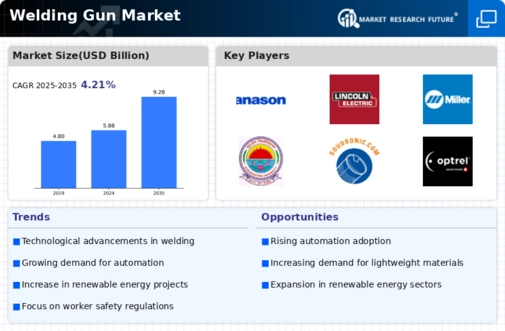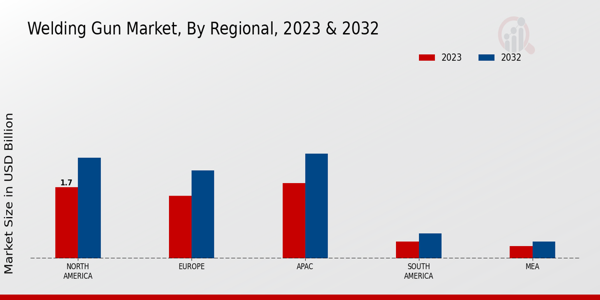Market Growth Projections
The Global Welding Gun Market Industry is projected to experience substantial growth over the next decade. With a market value of 5.88 USD Billion in 2024, it is anticipated to reach 9.28 USD Billion by 2035, reflecting a CAGR of 4.24% from 2025 to 2035. This growth trajectory is driven by various factors, including technological advancements, increased automation, and rising construction activities. As industries continue to evolve and adapt to new challenges, the demand for efficient and reliable welding solutions is expected to rise, positioning the welding gun market for a promising future.
Technological Advancements
Technological advancements play a pivotal role in shaping the Global Welding Gun Market Industry. Innovations such as laser welding and advanced arc welding techniques are revolutionizing the welding process, offering enhanced speed and quality. These technologies enable manufacturers to produce stronger and more durable welds, which is particularly crucial in industries like automotive and aerospace. As companies increasingly adopt these cutting-edge solutions, the demand for sophisticated welding guns is expected to rise. This shift towards high-tech welding equipment is likely to contribute significantly to the market's growth trajectory over the coming years.
Rising Demand for Automation
The Global Welding Gun Market Industry experiences a notable increase in demand for automation across various sectors, particularly in manufacturing and construction. As industries strive for efficiency and precision, automated welding solutions are becoming essential. This trend is evidenced by the projected market growth from 5.88 USD Billion in 2024 to 9.28 USD Billion by 2035, reflecting a compound annual growth rate (CAGR) of 4.24% from 2025 to 2035. Automation not only enhances productivity but also reduces human error, thereby driving the adoption of advanced welding guns that integrate seamlessly with robotic systems.
Growth in Construction Activities
The Global Welding Gun Market Industry is significantly influenced by the growth in construction activities worldwide. As urbanization accelerates, the demand for infrastructure development, including residential and commercial buildings, is on the rise. Welding guns are integral to various construction processes, such as steel fabrication and assembly. This surge in construction projects not only drives the need for welding equipment but also encourages manufacturers to innovate and improve their offerings. Consequently, the market is poised for expansion, with projections indicating a robust growth trajectory as construction activities continue to flourish globally.
Increasing Focus on Safety Standards
The Global Welding Gun Market Industry is witnessing a heightened focus on safety standards and regulations. As industries prioritize worker safety, the demand for welding guns that comply with stringent safety guidelines is increasing. Enhanced safety features, such as automatic shut-off mechanisms and improved ergonomics, are becoming essential in welding equipment. This trend is particularly evident in sectors like shipbuilding and heavy machinery, where safety is paramount. The emphasis on safety not only protects workers but also reduces liability for companies, thereby driving the adoption of advanced welding technologies that meet these evolving standards.
Environmental Sustainability Initiatives
The Global Welding Gun Market Industry is increasingly influenced by environmental sustainability initiatives. As companies strive to reduce their carbon footprint, there is a growing demand for eco-friendly welding solutions. Innovations such as low-emission welding guns and energy-efficient technologies are gaining traction. These advancements not only align with global sustainability goals but also appeal to environmentally conscious consumers. As regulations around emissions tighten, manufacturers are compelled to invest in greener technologies, which is likely to drive the growth of the welding gun market. This shift towards sustainability is expected to shape the industry's future landscape.













